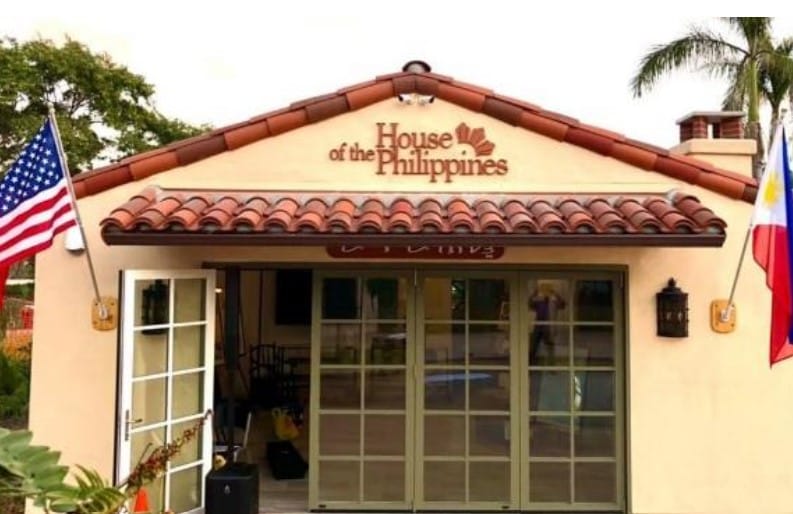A NEW ‘HOUSE OF THE PHILIPPINES’ IS COMING SOON

BUT THEY NEED YOUR HELP TO GET IT DONE!
By Adam Behar
Since 1961 the House of the Philippines in Balboa Park has shared a cottage with the House of France. A group of Fil-Am community leaders has been working tirelessly over the past several years to turn their vision of a separate, standalone House of the Philippines into a reality. Construction is already underway –in fact it began back in June and the group is getting close to achieving this important milestone for the community.
But unfortunately, delays with obtaining city permits, rising construction costs, and COVID-19 have resulted in unexpected expenses, according to Rom Sarno, president of the House of the Philippines’ board of directors. This means they need to raise $150,000 in order to complete construction on the final 20 percent of the project and meet their goal of opening to the public in spring of next year.
The board of directors is asking for members of San Diego County’s Fil-Am community to contribute to this important cause. “The new House of the Philippines will be like a second home for our community,” said Rommel Alberto, co-vice president. “Contributions of any amount are needed and greatly appreciated.” (Editor’s Note: Donations can be made at www.houseofthephilippines.org.) The fundraising campaign ends December 31, 2020.
The new House of the Philippines will be located behind the Hall of Nations and next to the House of Iran in Balboa Park, said Mr. Alberto. It will include a 500-square-foot space and resemble a “mini museum,” he said. It will feature cultural and historical displays, videos, and photographic exhibits. Special events and activities will be held throughout the year.
Given that there are more than 200,000 Filipinos living in San Diego County, it’s hard to believe there’s not a Filipino American cultural center in San Diego, said Joe Mazares, a member of the fundraising committee. He points out that in most other cities with large concentration of Filipino Americans – Los Angeles, Carson, Daly City, San Francisco, Virginia Beach – you find Filipino American cultural centers. They celebrate the culture, history, and traditions and serve as a gathering place for the local Fil-Am community. At 500-square-feet, the House of the Philippines may not be big enough to constitute a cultural center but it is a big step in that direction, said Mazares.
“The House of the Philippines is like a home,” said Mazares. It helps provide that connection between our newly arrived immigrant communities, people who are transitioning to San Diego, and those who have been here for a few generations. We are that bridge for the community.” Mazares urges proud Filipino Americans to contribute to the fundraising campaign “because the House of the Philippines is not just for you, but also for future generations to come.”
It is also a symbol. It sends a message to the larger community and to future generations that the Fil-Am community is on the map. It’s not invisible. So it really speaks to the sense of belonging and identity that is so critical to everyone’s sense of well-being. House of the Philippines’ treasurer Sam Besa said, “The story of the Philippines certainly has helped us achieve that sense of identity. But that story, you know, doesn't end once we arrived here; that story continues today.” The House of the Philippines is where that story will be told.
The movement to build a separate House of the Philippines also speaks to a bigger change that is occurring in San Diego’s Fil-Am community, as a younger generation rises and begins taking on leadership positions not only in the medical field or business sector but also in politics, arts and culture, and community advocacy.
If earlier generations of San Diego’s Filipino community were, understandably, more focused on assimilation and fitting in, now a new generation of Filipino Americans wants to reclaim their identity and history. They want their voice to be heard and they want to have an impact. Consider rock star chef and entrepreneur Phillip Esteban, who is helping to shape the new National City, or Bennett Peji, who speaks passionately about the importance of identity, place, and belonging for Filipino Americans, and who was recently appointed as chairman of the board of California Humanities by Governor Newsom.
Then there’s Noli Zosa, the charismatic part-owner of the Dirty Birds chain, who ran a strong campaign to serve on the San Diego City Council; and Lorna Delos Santos and Ditas Delossantos Yamane who competed for seats on the City Council of National City. Of course there’s also San Diego’s new mayor, Todd Gloria, a rising star who is proud of his Filipino ancestry, and Fox News 5 San Diego morning news anchor Kristina Audencial, among many other Fil-Am San Diegans who refuse to be invisible. It’s a new generation!
Mr. Besa, who’s been involved with the House of Philippines for ten years, told me that there is a feeling among many in the community that the contribution of Filipino Americans to the region is not well known by locals and visitors. The history is also not well known, especially by younger generations. This underscores the need, he said, for the Fil-Am community to have its very own House of the Philippines in Balboa Park. “The House of the Philippines,” said Mr. Besa, “is a place where we as a group can tell our story: What is our story? How do we connect to the United States? And for us to share our culture so visitors have a sense of what our values are and what our history has been and what, and how, we've contributed.”
San Diego’s Filipino flavor is undeniable. There are more than 200,000 Filipinos and Filipino Americans living in all parts of San Diego County, from Mira Mesa and Rancho Penasquitos to Oceanside and Vista to National City and Chula Vista. Mariel Schmidt, the house’s vice president in charge of membership, pointed out that, according to a 2010 SANDAG survey, after Spanish, Tagalog is the most widely spoken language in San Diego County among bilingual residents.
Rommel Alberto, the board co-VP, observed that Filipinos were among some of San Diego’s original locals and they have a history with San Diego that dates back to the founding of the city. “They were a part of the Portola Expedition,” he said of the 18th century explorers who were the first Europeans to reach what would later become San Diego. “There were at least two Filipinos who were aboard the ship that came to San Diego. The Portola Expedition eventually led to the founding of the City of San Diego.”
Mr. Alberto emphasized that the House of Philippines board has been fortunate to have the support of many in the community, for which he is very grateful. He credits Audie De Castro, the Philippine Honorary Consul of San Diego, for opening many doors for the group. For this final fundraising push, the board is counting on the support of the community. This makes sense since members of the Fil-Am community and their offspring will benefit from and enjoy this beautiful house in Balboa Park.
Please donate today at www.houseofthephilippines.org/donations.


